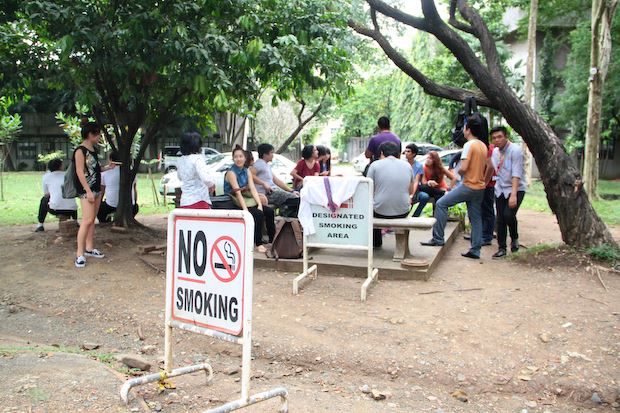The Office of the Vice President for Administration (OVPA) issued a total ban on smoking in all Ateneo-owned properties effective November 15, superseding a no smoking policy implemented in 2009.
In a memo released by the OVPA on September 23, Vice President for Administration Nemesio Que, SJ stated that “it is deemed necessary to declare a total ban of smoking in all Ateneo de Manila University properties.”
This includes the following: The Ateneo de Manila University in Loyola Heights, the Ateneo Professional Schools, the Ateneo School of Medicine and Public Health and the other Ateneo satellite campuses.
The recent declaration of a total ban of smoking is in compliance with Republic Act (RA) Number 9211, also known as the “Tobacco Regulation Act of 2003.”
The RA prohibits smoking in “centers of youth activity such as play schools, elementary schools, high schools, colleges and universities.”
Specifics of the policy
According to the memo, the new policy was made after a review of the original no smoking policy in the Ateneo.
The memo said that the decision to implement a total smoking ban was made “to further the university’s commitment to provide a healthy and sustainable learning and working environment for all members of the community.”
In an interview with The GUIDON, Que reminded the Ateneo community that the implementation of the ban doesn’t just apply to students.
“Everyone is encouraged to remind fellow community members and visitors of the total ban,” he said.
In addition, the memo also specified that all visitors, suppliers, contractors and couriers inside the Ateneo campuses are required to observe the ban as well.
Loopholes
Despite the existence of RA 9211, the Ateneo Loyola Heights campus had smoking pocket gardens or “smockets” until this year.
According to an article published in the University Inquirer on March 22, 2010, the Ateneo put up the smockets as a response to the RA. They were to act as a transition mechanism to the eventual ban of smoking on campus.
In the same article, then-incoming Loyola Schools Vice President John Paul Vergara, PhD said that several Department of Health officials pointed out that the smockets in the North parking area, the Northeast parking area and the Institute of Social Order violated the RA.
Que then deemed it necessary to conduct a review of the no smoking policy that was implemented in 2009.
“In 2009, part of the [conditions of the] no smoking policy was that it be reviewed after a designated period,” he said.
“With the growing Ateneo population and areas of the University becoming more accessible to students and other members of the community, it was deemed necessary to implement measures that are more accordant with the law,” Que added.
The University Inquirer was a final project of a group of Ateneans who took the News Writing class under Communication Department Associate Professor Chay Hofileña in school year 2009 to 2010.
Pros and cons
The total ban on smoking received mixed reactions from the Ateneo community, with both smokers and non-smokers expressing displeasure over the policy.
Freshman Jeremias Esguerra, a smoker, had a negative reaction to the ban of smoking on campus.
“Personally, I disagree, first and foremost because I smoke, so it would really be a hassle to go out of the campus just to smoke a couple of sticks,” he said.
He added that the ban will force Ateneans to smoke outside the campus, which will expose them to hazards like robbery, kidnapping and the like.
English Department Lecturer Carlo Rivera IV, a non-smoker, talked about the loss of a subculture that resulted from the ban. According to him, the smockets were places “where friends could get together.”
“You ended up becoming friends with a lot of people who were very different from you, and the only thing you might have shared was that you enjoyed nicotine,” he said.
“[The smocket] created avenues for friendships [and] for letting off steam. [That subculture] is a real loss. [That subculture] meant a lot to a lot of people,” added Rivera.
Junior Rachelle Rivera, a non-smoker, also sees a negative side effect of the ban.
“A lot of people smoke because it relieve[s] their stress or give[s] them focus,” she said.
“Once [the ban] is implemented, smokers might feel deprived of their stress coping mechanism,” Rachelle Rivera added.
However, Esguerra said that he also sees the logic behind the ban.
“The obvious pro in this ban is that we will have cleaner air inside the campus,” he said.
“And the banning of smoking inside the school might trigger quitting among the previous smokers in the smocket,” Esguerra added.
Future implications
Members of the Ateneo community believe that the ban will cause several changes within the Ateneo.
In an online article published by The GUIDON last October entitled “Ashes to ashes,” a frequenter of the smocket said, “We’ll probably be seeing much more smoking right outside Gates 2.5 and 3.5 since the guards can’t do anything about it. These are major highways for college students, but grade school and high school kids as well.”
With the possibility of grade school and high school students exposed to smoking, Rivera IV hopes that “a solution can be found for the smokers on campus.”
In the long run, Que is hoping that the implementation of the ban will enable the Ateneo “to provide a healthier and more sustainable learning and working environment.”
“But, just like any change, people will discuss it, both pro and con,” he added.
Que further said, “We have an environment that welcomes such discussions and the administration is always available to lend an ear.”







